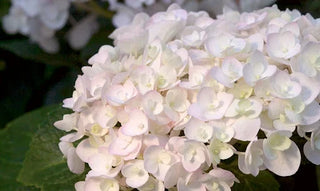The lacecap hydrangea, so-named for the ring of larger (sterile) flowers that encircle the center cluster of fertile flowers.
A plant that’s ready for root pruning. Roots have grown to the edge of the mass.

Slicing off pieces of the mass with a soil knife.

A clump of congested roots, sliced from the bottom of the mass.

After root-pruning, the mass is smaller, and some of the roots have been teased out.

The root-pruned, repotted hydrangea.

There was a time when I got a little crazy for blue hydrangeas. I was just getting my start as a garden professional and I’d been reading a lot about the blue mopheads that were decidedly not hardy in my zone. I was especially obsessed with a variety called Nikko Blue, which I grew in a large pot and overwintered in my basement. The next year, I added some blue lacecaps: Blue Billow, Bluebird and Miranda. Today, the collection has grown to eight shrubs, all growing in large pots — most larger than 12″ across.
All of these cultivars are hardy in southern New England, but not up here. If I planted them in the ground, they’d be killed to the ground for sure. Chances are good that they’d start growing from the roots, but they would never bloom. Reason: The flowers form on the prior season’s growth, also known as “old wood.” That’s the reason for the pots, the lugging up and down the basement stairs.
Over the years, I’ve found I can contain the shrubs in their pots by pruning the roots every couple years or so. This also creates an opportunity to rejuvenate the hydrangeas with fresh soil, a bit of granular fertilizer and some garden sulphur to ensure good blue color.
Root pruning sounds pretty harsh, and it is. But the plants respond well. You can do it with many potted plants, including houseplants. I have a camellia and a crapemyrtle that get root-pruned, too. Yes, more plants that aren’t hardy here, but only one of each.
I prune the roots in early spring before the plants start leafing out. The hardest part is getting the mass of soil and roots to come out of the pot. Once it’s out, start shaving the rootball with a soil knife or a Japanese hori. You can use the jagged edge to saw off slices of soil and roots. It’s a good idea to trim the bottom of the mass, too. I usually shave about 1 or 2 inches off the mass — more if the plant is large and root-bound. I use the tip of the knife to tease out a few of the roots.
I plant the reduced mass in the original pot with fresh soil to fill the gaps. Water well, and the plant is ready for other couple of years.
Since I began my collection more than 10 years ago, growers have discovered a blue hydrangea that blooms on old wood and new wood. It’s called Endless Summer and they’re being planted everywhere. Time for a new obsession. Maybe some more of those crapemyrtles …

For More Information
- Read The Truth About Blue Hydrangeas: You may have heard that you can change the color of a hydrangea’s flowers by adjusting soil pH. But there’s a little more to it than that.
Buy Endless Summer Hydrangeas for your own garden




